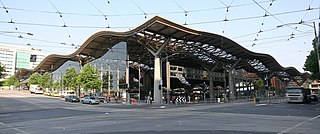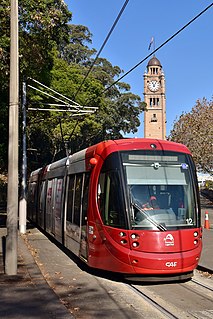
Trams are a major form of public transport in Melbourne, the capital city of the state of Victoria, Australia. As of May 2017, the Melbourne tramway network consists of 250 kilometres of double track, 493 trams, 24 routes, and 1,763 tram stops. The system is the largest operational urban tram network in the world. Trams are the second most used form of public transport in overall boardings in Melbourne after the commuter railway network, with a total of 206 million passenger trips in 2017–18.

Southern Cross railway station is a major railway station in Docklands, Melbourne. It is on Spencer Street, between Collins and La Trobe Streets, at the western edge of the Melbourne central business district. The Docklands Stadium sports arena is 500 metres north-west of the station.

Docklands is an inner-city suburb in Melbourne, Victoria, Australia, 2 km (1.2 mi) west of Melbourne's Central Business District, located within the City of Melbourne local government area. Docklands recorded a population of 15,495 at the 2021 census.

The City Circle is a zero-fare tram running around the Melbourne central business district in Australia. Aimed mainly at tourists, the route passes many Melbourne attractions while running along the city centre's outermost thoroughfares, as well as the developing Docklands waterfront precinct. It operates in both clockwise and anti-clockwise direction.

Thornbury is an inner-city suburb in Melbourne, Victoria, Australia, 7 km (4.3 mi) north-east of Melbourne's Central Business District, located within the City of Darebin local government area. Thornbury recorded a population of 19,005 at the 2021 census.

Parliament railway station is an underground railway station in Melbourne, Australia. It is one of the five stations on the City Loop, which encircles the Melbourne CBD. In 2017/2018 it was the fourth busiest station on Melbourne's metropolitan network, with 10.19 million passenger movements.

North Richmond railway station is located on the Mernda and Hurstbridge lines in Victoria, Australia. It serves the inner eastern Melbourne suburb of Richmond, and opened on 21 October 1901.

Bourke Street is one of the main streets in the Melbourne central business district and a core feature of the Hoddle Grid. It was traditionally the entertainment hub of inner-city Melbourne, and is now also a popular tourist destination and tram thoroughfare.

Melbourne Central railway station is an underground station on the electrified railway network in Melbourne, Australia. It is one of five stations on the City Loop, which encircles the Melbourne CBD. The station is located under La Trobe Street, between Swanston and Elizabeth Streets, on the northern edge of the central business district (CBD). The station is named after the Melbourne Central Shopping Centre, which it is beneath. It feeds into Melbourne's main metro network station, Flinders Street, and also Southern Cross, Melbourne's main regional terminus. In 2017/2018, it was the third-busiest station on the Melbourne metropolitan rail network, with 15.859 million passenger movements.

Melbourne tram route 86 is operated by Yarra Trams on the Melbourne tram network from Bundoora RMIT to Waterfront City. The 22.2 kilometre route is operated out of Preston depot with E class trams.

The Melbourne central business district is the city centre and main urban area of the city of Melbourne, Victoria, Australia, centred on the Hoddle Grid, the oldest part of the city laid out in 1837, and includes its fringes. The Melbourne CBD is located in the local government area of the City of Melbourne which also includes some of inner suburbs adjoining the CBD.

Until 1958, trams formed a network spanning most of Adelaide, with a history dating back to 1878. Adelaide ran horse trams from 1878 to 1914 and electric trams from 1909, but has primarily relied on buses for public transport since the mid-20th century. Electric trams, and later trolleybuses, were Adelaide's main method of public transport throughout the life of the electric tram network. The tram network was progressively closed down through the 1950s with the last lines closing in 1958; the Glenelg tram line was the only line to survive these closures and has remained in operation ever since and has been progressively upgraded and extended since 2005.

The earliest trams in Australia operated in the latter decades of the 19th century, hauled by horses or "steam tram motors". At the turn of the 20th century, propulsion almost universally turned to electrification, although cable trams lingered in Melbourne. In cities and towns that had trams, they were a major part of public transport assets.

Melbourne is the capital and largest city of the Australian state of Victoria, and the second-most populous city in both Australia and Oceania. Its name generally refers to a 9,993 km2 (3,858 sq mi) metropolitan area known as Greater Melbourne, comprising an urban agglomeration of 31 local municipalities, although the name is also used specifically for the local municipality of City of Melbourne based around its central business area. The metropolis occupies much of the northern and eastern coastlines of Port Phillip Bay and spreads into the Mornington Peninsula, West Gippsland, as well as the hinterlands towards the Yarra Valley, the Dandenong and Macedon Ranges. It has a population over 5 million, mostly residing to the east side of the city centre, and its inhabitants are commonly referred to as "Melburnians".

SkyBus is an airport bus service operating in Australia in Melbourne, Hobart, Brisbane and in Auckland, New Zealand.

The Metro Tunnel is a metropolitan rail infrastructure project currently under construction in Melbourne, Australia. It includes the construction of twin 9-kilometre rail tunnels between South Kensington and South Yarra with five new underground stations. The southern portal for the tunnel is to be located to the south of South Yarra station. As a result, the tunnel will connect the Pakenham and Cranbourne lines with the Sunbury line, and allow these lines to bypass Flinders Street station and the City Loop while still stopping in the Melbourne central business district.

The history of Manchester Metrolink begins with its conception as Greater Manchester's light rail system in 1982 by the Greater Manchester Passenger Transport Executive, and spans its inauguration in 1992 and the successive phases of expansion.
Numerous proposals have been made for improvements to the Melbourne tram network, the largest such network in the world. Nearly all of these have been for track extensions of existing lines to connect with nearby railway station or to service new areas and suburbs.

The District Docklands is an indoor/outdoor shopping centre in the suburb of Docklands in the inner-west of Melbourne.



















